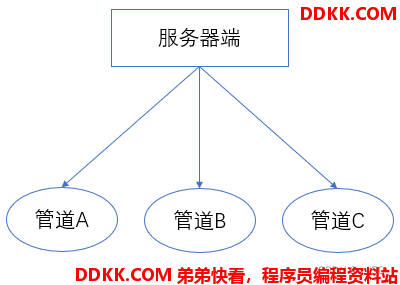一、任务队列
1、 用户程序自定义的普通任务;
2、 用户自定义定时任务;
3、 非当前Reactor线程调用Channel的各种方法;
例如在推送系统的业务线程里面,根据用户的标识,找到对应的Channel引用,然后调用Write类方法向该用户推送消息,就会进入到这种场景。最终的Write会提交到任务队列中后被异步消费。
二、使用场景
1、 比如在服务器端channelRead中有一个非常耗费时间的业务,我们要异步执行,把它提交到channel对应的NioEventLoopGroup的taskQueue中;
2、 每个NioEventLoop是一个单线程线程池,提交任务相当于还是它自己来做,只不过是它会根据你设定的ioradio参数来分配io事件和普通任务的时间;
三、方案1:用户程序自定义的普通任务
1、 改写服务器端Handler,为NettyChannelHandler2.java;
package com.ddkk.netty.simple;
import io.netty.buffer.ByteBuf;
import io.netty.buffer.Unpooled;
import io.netty.channel.ChannelHandlerContext;
import io.netty.channel.ChannelInboundHandlerAdapter;
import io.netty.util.CharsetUtil;
/**
* 说明
* 1. 我们自定义一个Handler,需要继承netty规定好的某个HandlerAdapter(规范)
* 2. 这时我们自定义一个Handler,才能称之为Handler
*
*/
public class NettyChannelHandler2 extends ChannelInboundHandlerAdapter {
//读取数据的事件(这里我们可以读取客户端发送的消息)
/*
* 1. ChannelHandlerContext ctx:上下文对象,含有管道pipeline,通道channel,地址
* 2. Object msg:就是客户端发送的数据,默认是Object
* 3. 通道读写数据,管道处理数据
*/
@Override
public void channelRead(ChannelHandlerContext ctx, Object msg) throws Exception {
//方案1:用户程序自定义的普通任务
//会提交到当前channel关联的NioEventLoop里面的taskQueue执行
//任务一
ctx.channel().eventLoop().execute(new Runnable() {
@Override
public void run() {
try {
Thread.sleep(10 * 1000);
ctx.channel().writeAndFlush(Unpooled.copiedBuffer("hello,客户端~", CharsetUtil.UTF_8));
} catch (InterruptedException e) {
// TODO Auto-generated catch block
e.printStackTrace();
}
}
});
//任务二
ctx.channel().eventLoop().execute(new Runnable() {
@Override
public void run() {
System.out.println("任务二...");
ctx.channel().writeAndFlush(Unpooled.copiedBuffer("hello,客户端3~", CharsetUtil.UTF_8));
}
});
ctx.channel().writeAndFlush(Unpooled.copiedBuffer("hello,客户端2~", CharsetUtil.UTF_8));
//客户端
//会收到:hello,客户端2~
//再收到:hello,客户端~
//再收到:hello,客户端3~
}
//数据读取完毕
//这个方法会在channelRead读完后触发
@Override
public void channelReadComplete(ChannelHandlerContext ctx) throws Exception {
//把数据写到缓冲区,并且刷新缓冲区,是write + flush
//一般来讲,我们对这个发送的数据进行编码
//ctx.channel().writeAndFlush(Unpooled.copiedBuffer("hello,客户端~", CharsetUtil.UTF_8));
}
//处理异常,一般是需要关闭通道
@Override
public void exceptionCaught(ChannelHandlerContext ctx, Throwable cause) throws Exception {
ctx.channel().close();
}
}
2、 客户端执行结果;
服务器回复的消息:hello,客户端2~
服务器的地址:/127.0.0.1:6668
服务器回复的消息:hello,客户端~
服务器的地址:/127.0.0.1:6668
服务器回复的消息:hello,客户端3~
服务器的地址:/127.0.0.1:6668
服务器端nioeventloop还是一个线程执行,taskQueue里是按照添加的顺序依次执行。
四、方案2:用户自定义定时任务
1、 该任务是提交到scheduleTaskQueue中;
2、 改写服务器端Handler,为NettyChannelHandler3.java;
package com.ddkk.netty.simple;
import java.util.concurrent.TimeUnit;
import io.netty.buffer.ByteBuf;
import io.netty.buffer.Unpooled;
import io.netty.channel.ChannelHandlerContext;
import io.netty.channel.ChannelInboundHandlerAdapter;
import io.netty.util.CharsetUtil;
/**
* 说明
* 1. 我们自定义一个Handler,需要继承netty规定好的某个HandlerAdapter(规范)
* 2. 这时我们自定义一个Handler,才能称之为Handler
*
*/
public class NettyChannelHandler3 extends ChannelInboundHandlerAdapter {
//读取数据的事件(这里我们可以读取客户端发送的消息)
/*
* 1. ChannelHandlerContext ctx:上下文对象,含有管道pipeline,通道channel,地址
* 2. Object msg:就是客户端发送的数据,默认是Object
* 3. 通道读写数据,管道处理数据
*/
@Override
public void channelRead(ChannelHandlerContext ctx, Object msg) throws Exception {
//方案2:用户自定义定时任务
ctx.channel().eventLoop().schedule(new Runnable() {
@Override
public void run() {
try {
Thread.sleep(10 * 1000);
ctx.channel().writeAndFlush(Unpooled.copiedBuffer("hello,客户端~", CharsetUtil.UTF_8));
} catch (InterruptedException e) {
// TODO Auto-generated catch block
e.printStackTrace();
}
}
}, 5, TimeUnit.SECONDS); //延迟5秒,然后执行
ctx.channel().writeAndFlush(Unpooled.copiedBuffer("hello,客户端2~", CharsetUtil.UTF_8));
}
//数据读取完毕
//这个方法会在channelRead读完后触发
@Override
public void channelReadComplete(ChannelHandlerContext ctx) throws Exception {
//把数据写到缓冲区,并且刷新缓冲区,是write + flush
//一般来讲,我们对这个发送的数据进行编码
//ctx.channel().writeAndFlush(Unpooled.copiedBuffer("hello,客户端~", CharsetUtil.UTF_8));
}
//处理异常,一般是需要关闭通道
@Override
public void exceptionCaught(ChannelHandlerContext ctx, Throwable cause) throws Exception {
ctx.channel().close();
}
}
3、 客户端执行结果;
服务器回复的消息:hello,客户端2~
服务器的地址:/127.0.0.1:6668
服务器回复的消息:hello,客户端~
服务器的地址:/127.0.0.1:6668
五、方案3:服务器端要推送多个管道
1、 服务器端要推送到管道A、管道B、管道C,所以要找到它对应的channel;

2、 如何获取其他的channel;
1、在服务器端初始化new ChannelInitializer<Socket hannel>()对象时,把SocketChannel放入一个HashMap中,然后从HashMap里取。
2、在推送消息时,可以将业务加入到各个channel对应的NioEventLoop的taskQueue或者scheduleTaskQueue中。
3、 改写服务端,为NettyServer2.java;
package com.ddkk.netty.simple;
import java.util.Map;
import java.util.concurrent.ConcurrentHashMap;
import io.netty.bootstrap.ServerBootstrap;
import io.netty.channel.ChannelFuture;
import io.netty.channel.ChannelInitializer;
import io.netty.channel.ChannelOption;
import io.netty.channel.ChannelPipeline;
import io.netty.channel.EventLoopGroup;
import io.netty.channel.nio.NioEventLoopGroup;
import io.netty.channel.socket.SocketChannel;
import io.netty.channel.socket.nio.NioServerSocketChannel;
/**
* 可以传递一个集合保存SocketChannel的引用
* @author user
*
*/
public class NettyServer2 {
public static void main(String[] args) throws Exception {
//创建BossGroup和WorkerGroup
//说明
//1. 创建两个线程组bossGroup和workerGroup
//2. bossGroup它只是处理连接请求,真正的与客户端业务处理会交给workerGroup去完成
//3. 两个都是无限循环
EventLoopGroup bossGroup = new NioEventLoopGroup(1);
EventLoopGroup workerGroup = new NioEventLoopGroup(8);
try {
//创建服务器端的启动对象,配置启动参数
ServerBootstrap bootstrap = new ServerBootstrap();
//集合保存所有SocketChannel引用
Map<Integer, SocketChannel> map = new ConcurrentHashMap<>();
//使用链式编程来进行设置
bootstrap.group(bossGroup, workerGroup) //设置两个线程组
.channel(NioServerSocketChannel.class) //使用NioServerSocketChannel作为服务器的通道实现
.childHandler(new ChannelInitializer<SocketChannel>() { //创建一个通道初始化对象
//给pipeline设置处理器
@Override
protected void initChannel(SocketChannel ch) throws Exception {
//将channel引用放入map
map.put(ch.hashCode(), ch);
ChannelPipeline pipeline = ch.pipeline();
pipeline.addLast(new NettyChannelHandler4(map)); //向管道的最后增加一个处理器
};
}); //给我们的workerGroup的EventLoop对应的管道设置处理器
//bossGroup参数
bootstrap.option(ChannelOption.SO_BACKLOG, 1024); //设置线程队列等待连接的个数
//workerGroup参数
bootstrap.childOption(ChannelOption.SO_KEEPALIVE, true); //设置保持活动连接状态
System.out.println("...服务器 is ready...");
//绑定一个端口并且同步,生成了一个ChannelFuture对象
//启动服务器并绑定端口
ChannelFuture cf = bootstrap.bind(6668).sync();
//对关闭通道进行监听
cf.channel().closeFuture().sync();
} catch (Exception e) {
e.printStackTrace();
} finally {
System.out.println("Shutdown Netty Server...");
//优雅的关闭
workerGroup.shutdownGracefully();
bossGroup.shutdownGracefully();
System.out.println("Shutdown Netty Server Success!");
}
}
}
4、 改写服务端Handler,为NettyChannelHandler4.java;
package com.ddkk.netty.simple;
import java.util.Map;
import io.netty.buffer.Unpooled;
import io.netty.channel.ChannelHandlerContext;
import io.netty.channel.ChannelInboundHandlerAdapter;
import io.netty.channel.socket.SocketChannel;
import io.netty.util.CharsetUtil;
/**
* 说明
* 1. 我们自定义一个Handler,需要继承netty规定好的某个HandlerAdapter(规范)
* 2. 这时我们自定义一个Handler,才能称之为Handler
*
*/
public class NettyChannelHandler4 extends ChannelInboundHandlerAdapter {
private Map<Integer, SocketChannel> map;
public NettyChannelHandler4(Map<Integer, SocketChannel> map) {
this.map = map;
}
//读取数据的事件(这里我们可以读取客户端发送的消息)
/*
* 1. ChannelHandlerContext ctx:上下文对象,含有管道pipeline,通道channel,地址
* 2. Object msg:就是客户端发送的数据,默认是Object
* 3. 通道读写数据,管道处理数据
*/
@Override
public void channelRead(ChannelHandlerContext ctx, Object msg) throws Exception {
System.err.println("channel的数量:" + map.size());
//方案3:服务器端要推送到管道A、管道B、管道C。。。
map.forEach((key, value) -> {
value.writeAndFlush(Unpooled.copiedBuffer("server向"+key+"发送消息", CharsetUtil.UTF_8));
});
}
//数据读取完毕
//这个方法会在channelRead读完后触发
@Override
public void channelReadComplete(ChannelHandlerContext ctx) throws Exception {
//把数据写到缓冲区,并且刷新缓冲区,是write + flush
//一般来讲,我们对这个发送的数据进行编码
//ctx.channel().writeAndFlush(Unpooled.copiedBuffer("hello,客户端~", CharsetUtil.UTF_8));
}
//处理异常,一般是需要关闭通道
@Override
public void exceptionCaught(ChannelHandlerContext ctx, Throwable cause) throws Exception {
//客户端主动断开连接时会进到这里
//移除集合
map.remove(ctx.channel().hashCode());
ctx.channel().close();
}
}
六、netty模型方案再说明
1、 netty抽象出两组线程池,BossGroup专门负责接收客户端连接,WorkerGroup专门负责网络读写操作;
2、 NioEventLoop表示一个不断循环执行处理任务的线程,每个NioEventLoop都有一个selector,用于监听绑定在其上的socket网络通道;
3、 NioEventLoop内部采用串行化设计,从消息的读取->解码->处理->编码->发送,始终由IO线程NioEventLoop负责;
4、 NioEventLoopGroup下包含多个NioEventLoop;
1、每个NioEventLoop中包含有一个Selector,一个taskQueue。
2、每个NioEventLoop的Selector上可以注册监听多个NioChannel。
3、每个NioChannel只会绑定在唯一的NioEventLoop上。
4、每个NioChannel都绑定有一个自己的ChannelPipeline。